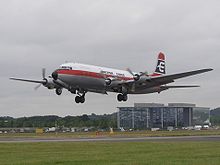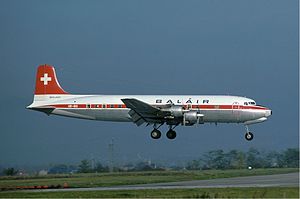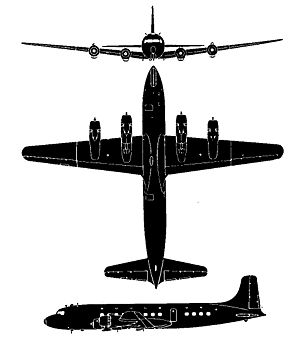- Douglas DC-6
-
DC-6 Douglas DC-6B of Swiss airline Balair in 1976 Role Airliner/transport aircraft Manufacturer Douglas Aircraft Company First flight February 15, 1946 Introduction March 1947 Status in use Primary users Pan American World Airways
Northwest Orient
Capital Airlines
Delta AirlinesProduced 1946 - 1958 Number built 704 Developed from Douglas DC-4 Variants Douglas DC-7 The Douglas DC-6 is a piston-powered airliner and transport aircraft built by the Douglas Aircraft Company from 1946 to 1958. Originally intended as a military transport near the end of World War II, it was reworked after the war to compete with the Lockheed Constellation in the long-range commercial transport market. More than 700 were built and many still fly today in cargo, military and wildfire control roles.
The DC-6 was known as the C-118 Liftmaster in United States Air Force service and as the R6D in United States Navy service prior to 1962 after which all U.S. Navy variants were also designated as the C-118.
Contents
Design and development
The United States Army Air Forces commissioned the DC-6 project as the XC-112 in 1944. The Air Force wanted an expanded, pressurized version of the popular C-54 Skymaster transport with improved engines. By the time the XC-112 flew the war was over and the USAAF had rescinded its requirement.
Douglas converted its prototype into a civil transport (redesignated YC-112A, having significant differences from subsequent production DC-6 aircraft) and delivered the first production DC-6 in March 1947. However, a series of mysterious inflight fires (including the fatal crash of United Airlines Flight 608) grounded the DC-6 fleet later that year. The cause was found to be a fuel vent located adjacent to the cabin cooling turbine intake. All DC-6s in service were modified to correct the problem, and the fleet was flying again after just four months on the ground.
Operational history
 Sabena DC-6B arriving at Manchester in 1955 after a non-stop scheduled passenger flight from New York
Sabena DC-6B arriving at Manchester in 1955 after a non-stop scheduled passenger flight from New York Universal Newsreel about the DC-6
Universal Newsreel about the DC-6
Pan Am used a fleet of DC-6B aircraft to inaugurate its first trans-Atlantic tourist class flights, starting in 1952. Several European airlines quickly followed with their own transatlantic services. The DC-6A/B/C sub-types were capable of non-stop commercial flights from the eastern US to Europe but normally needed to refuel in Newfoundland when westbound against the prevailing headwinds.
Douglas designed four basic variants of the DC-6: the basic DC-6, and the longer fuselage, higher-gross-weight, longer range versions—the DC-6A with large cargo doors forward and aft of the wing on the port (left hand side) with a cargo floor; the DC-6B, designed for passenger work, with passenger doors only and a lighter floor; and the DC-6C convertible, with the two cargo doors and removable passenger seats.
The DC-6B, originally powered by Double Wasp engines with Hamilton Standard 43E60 constant speed reversing propellers, was regarded as the ultimate piston-engine airliner from the standpoint of ruggedness, reliability, economical operation and handling qualities.[1]
The military version, essentially similar to the DC-6A, was designated the USAF C-118 Liftmaster; the USN R6D version used the more powerful R-2800-CB-17 engines. These were later also used on the commercial DC-6B to accommodate international flights.[2]The R6D Navy version (in the late 1950s and early 1960s) had Curtiss Electric constant-speed reversing propellers.[citation needed]
The USAF and USN renewed their interest in the DC-6 during the Korean War, and ordered a total of 167 C-118/R6D aircraft, some of which later found their way into civilian service. Harry Truman's first presidential aircraft was an Air Force short fuselage DC-6 which was designated VC-118, and named "The Independence". It is preserved in the USAF Museum at Dayton, Ohio.
Total production of the DC-6 series was 704, including military versions.[3]
In the 1960s, two DC-6s were used as transmitter platforms for educational television, based at Purdue University, in a program called MPATI (Midwest Program for Airborne Television Instruction).[4]
Many older DC-6s were replaced in airline passenger service from the mid 1950s by the Douglas DC-7, but the simpler, more economical engines in the DC-6 has meant that the type has outlived the more sophisticated DC-7, particularly for cargo operations. DC-6/7s surviving into the Jet Age were replaced in front line inter-continental passenger service by Boeing 707 and Douglas DC-8 aircraft.
2006 marked the 60th anniversary of the introduction of the DC-6.
Variants
- XC-112A
- United States military designation of an improved version of the C-54 (DC-4); became the prototype DC-6. Eventually designated YC-112A, pressurized, P&W R-2800-83AM3 engines
- DC-6
- Initial production variant.
- DC-6A
- Freighter variant; fuselage slightly lengthened from DC-6 ; fitted with cargo door.
- DC-6B
- All-passenger variant of DC-6A, without cargo door.
- DC-6B-ST
- Swing tail freighter conversion to the DC-6B done by Sabena. Two converted.[5]
- DC-6C
- Convertible cargo/passenger variant.
- VC-118
- One DC-6 bought as a presidential transport with special 25 seat interior and 12 beds.
- C-118A
- Designation of DC-6As for the United States Air Force, 101 built.
- VC-118A
- C-118As converted as staff transports.
- C-118B
- R6D-1s re-designated.
- VC-118B
- R6D-1Zs re-designated.
- R6D-1
- United States Navy designation for the DC-6A, 65 built.
- R6D-1Z
- Four R6D-1s converted as staff transports.
Operators
Main article: Douglas DC-6 operators G-APSA in British Eagle scheme
G-APSA in British Eagle scheme
 A DC-6B N7919C belonged to Reeve Aleutian Airways in 1972
A DC-6B N7919C belonged to Reeve Aleutian Airways in 1972
- Current operators of the DC-6
- Today, most DC-6s are inactive, stored or preserved in museums, although a number are flying in northern bush operations in Alaska and Canada while several are based in Europe and a few other DC-6s are still in operation for small carriers in South America.
- One DC-6A, G-APSA, is in use at Coventry, UK. There is also a DC-6B, G-SIXC.[6] at the same site.
- One DC-6B is in use by Red Bull in Salzburg, Austria.
- One DC-6B V5-NCG "Bateleur" is in use with Namibia Commercial Aviation. This was the last DC-6 off the Douglas production line and the last DC-6 in the world in passenger configuration still flying commercially.[7]
- Several ( as of 2010 ) are in use as freighters or waterbombers in Canada. They are no longer used as retardant bombers in the western US.
- As of 2011, Everts Air Cargo operates eight DC-6s and two C-46s.
Civil operators
- Lóide Aéreo Nacional
- Panair do Brasil
- Real Transportes Aéreos
- Varig
- Kar Air DC-6B, DC-6B-ST
- Olympic Airways
- Spantax DC-6B, DC-6B-ST
- Syrian Air DC-6B, DC-6B/F
- Air Atlantique,now West Atlantic; a former cargo carrier based in Coventry, England.
- Cathay Pacific DC-6, DC-6B
- American Airlines DC-6, DC-6A, DC-6B
- United Air Lines DC-6, DC-6A, DC-6B
- Delta Air Lines DC-6
- Braniff International Airways DC-6, DC-6A, DC-6B
- National Airlines DC-6, DC-6B
- Northern Air Cargo DC-6A, DC-6B-ST
- Western Airlines DC-6B
- Pan American World Airways DC-6B
- Northwest Orient Airlines DC-6B
- Northeast Airlines DC-6A, DC-6B
- Eastern Air Lines DC-6B
- Pan American-Grace Airways DC-6, DC-6B
- Alaska Airlines DC-6A, DC-6B
- Continental Airlines DC-6B
- Pacific Southwest Airlines DC-6B
- Reeve Aleutian Airways DC-6B
- Trans Caribbean Airways DC-6B
- Flying Tiger Line DC-6A
- Mackey Airlines DC-6, DC-6B
- Everts Air Fuel
- Everts Air Cargo
- Zantop International Airlines DC-6B-ST
Military operators
- Belgian Air Force
Accidents and incidents
Main article: List of accidents and incidents involving the Douglas DC-6Survivors
Several DC-6s are preserved in museums. In all, There are 147 surviving aircraft including 47 airworthy ones.
- The most well-known is President Harry S. Truman's VC-118 Independence (s/n 46-505), which is preserved at the National Museum of the United States Air Force, Wright-Patterson Air Force Base in Dayton, Ohio. It was retired to the Museum in 1965.[8] In 1977–1978 museum personnel restored "Independence" to its former presidential markings and eagle-like paint scheme. The aircraft is on display in the Museum's Presidential Hangar.
- A DC-6B currently owned by Red Bull, was formally the private luxury transport of Yugoslav President Josip Broz Tito.[9]
- As of March 2010, there was a C-118 located in the "bone yard" of MCAS Cherry Point which was at one time the official aircraft of the Commandant of the Marine Corps. The aircraft was often left open to the weather and has deteriorated quite a bit, the interior is damaged, but the airframe is largely intact.
- The Navy's initial R6D, #128424, was converted along with six other #128 series R6Ds to VC executive transport configuration with delivery of #424 to VR-21, NAS Barbers Point in February 1955 remaining in service 28 ½ more years until October 1, 1983 based at Barbers Point as flag transportation for CINCPACFLT. #424 is now located at the National Naval Aviation Museum, NAS Pensacola, FL.
- A DC-6B ZS-MUL #45329 named Empress of Suva is preserved on a small holding at Wallmanstahl north of Pretoria South Africa. This aircraft was stored at Swartkops Air Force Base for over 10 years and after two years of restoration by enthusiasts was ferried to Wallmanstahl where a temporary runway had to be constructed.
- C-118 Liftmaster at Joint Base McGuire-Dix-Lakehurst, New Jersey; notable as the aircraft in which Elvis Presley returned to the United States after service in the US Army, based in Germany. Presently, as of October 2009[update], under restoration. [10]
Specifications
Variant DC-6 DC-6A DC-6B Crew Three to Four Capacity 48-56 Passengers 28,188 lb (12,786 kg) of Cargo 54 Passengers
(102 Max Seating)Length 100 ft 7 in (30.66 m) 105 ft 7 in (32.18 m) Wingspan 117 ft 6 in (35.81 m) Height 28 ft 5 in (8.66 m) Wing Area 1,463 sq ft (135.9 m2) Empty weight 52,567 lb (23,844 kg) 45,862 lb (20,803 kg) 55,357 lb (25,110 kg) Max takeoff weight 97,200 lb (44,100 kg) 107,200 lb (48,600 kg) 107,000 lb (49,000 kg) Powerplant (4x) Pratt & Whitney R-2800-CA15
"Double Wasp" radial engine,
1,800 hp (1,300 kW) with
water injection eachPratt & Whitney R-2800-CB16
"Double Wasp" radial engine,
2,400 hp (1,800 kW) eachPratt & Whitney R-2800-CB17
"Double Wasp" radial engine,
2,500 hp (1,900 kW) eachPropellers Hamilton Standard 43E60 "Hydromatic" constant speed props with autofeather and reverse thrust Cruise speed 311 mph (501 km/h) 315 mph (507 km/h) Range 3,983 nmi (7,377 km) 2,948 nmi (5,460 km) Max payload
4,317 nmi (7,995 km) Max fuel2,610 nmi (4,830 km) Max payload
4,100 nmi (7,600 km) Max fuelService ceiling 21,900 ft (6,700 m) 25,000 ft (7,600 m) Rate of climb 1,070 ft/min (330 m/min) Note of interest is that the diagram depicts the sleeper version. The very small windows above the standard ones permitted passengers in their Pullman-style bunks a view of the outside.
See also
- Related development
- Aircraft of comparable role, configuration and era
- Lockheed Constellation
- Lockheed L-049 Constellation
- Lockheed L-1049 Super Constellation
- Lockheed L-1649A Starliner
- Boeing 377
- Related lists
- List of military aircraft of the United States
- List of military aircraft of the United States (naval)
References
- Notes
- ^ Winchester 2004, pp. 130-131.
- ^ Winchester 2004, p. 131.
- ^ "Boeing History: DC-6/C-118A Liftmaster Transport." Boeing.com. Retrieved: October 3, 2011.
- ^ "Purdue University." ait.net. Retrieved: October 17, 2010.
- ^ "Douglas DC-6." Century Of Flight, 2003. Retrieved: September 13, 2011.
- ^ "The Six." thedc6.com. Retrieved: October 17, 2010.
- ^ "Douglas DC-6B." The Douglas DC-6 Association of South Africa. Retrieved: September 13, 2011.
- ^ United States Air Force Museum Guidebook 1975, p. 43.
- ^ "The Flying Bulls - DC-6B History." flyingbulls.at.Retrieved: September 13, 2011.
- ^ "Airmen Restore Aircraft Used by Elvis Presley." elvis.com, June 22, 2011. Retrieved: August 18, 2011.
- ^ "The Douglas DC-6." airliners.net. Retrieved: March 20, 2006.
- ^ "Douglas DC-6A." American Museum Of Aviation. Retrieved: September 13, 2011.
- Bibliography
- Pearcy, Arthur. Douglas Propliners: DC-1–DC-7. Shrewsbury, UK: Airlife Publishing, 1995. ISBN 1-85310-261-X.
- United States Air Force Museum Guidebook. Wright-Patterson AFB, Ohio; Air Force Museum Foundation, 1975.
- Whittle, John A. The Douglas DC-6 and DC-7 Series. Tonbridge, Kent, UK: Air Britain (Historians) Ltd., 1971. No ISBN.
- Winchester, Jim, ed. "Douglas DC-6". Civil Aircraft (The Aviation Factfile). London: Grange Books plc, 2004. ISBN 1-84013-642-1.
- Yenne, Bill. McDonnell Douglas: A Tale of Two Giants. Greenwich, Connecticut: Bison Books, 1985. ISBN 0-517-44287-6.
External links
Douglas military aircraft Fighters Ground attack Naval bombers
and attack aircraftBombers Observation Patrol PD · P2D · P3D
Reconnaisance Transports C-1 · C-21 · C-32 · C-33 · YC-34 · C-38 · C-39 · C-41 · C-41A · C-42 · C-47 · C-48 · C-49 · C-50 · C-51 · C-52 · C-53 · C-54 · C-58 · UC-67 · C-68 · C-74 · C-84 · C-110 · XC-112/YC-112 · XC-114 · YC-116 · C-117 · C-118 · C-124 · YC-129 · C-133 · XCG-17
C-9 · C-24
RD · R2D · R3D · R4D (R4D-2 & R4D-4) · R5D · JD · R6D
CC-129 · Dakota I/III/IV · Dakota II · LXD1 · PD.808 · Skymaster ITraining aircraft Experimental Douglas and McDonnell Douglas airliners Piston-engined Jet-engined Not developed DC-7 (Globemaster) · DC-7D · DC-8 (piston airliner) · DC-9 (Model 2067) · MD-91X/-92X/-94X · MD-12/-XX
USAAS/USAAC/USAAF/USAF transport designations 1925–1962, 2005-2006 Main sequence
1925-1962C-1 • C-2 • C-3 • C-4 • C-5 • C-6 • C-7 • C-8 • C-9 • XC-10 • Y1C-11 • Y1C-12 • C-13 (Not assigned) • C-14 • C-15 • C-16 • Y1C-17 • C-18 • C-19 • C-20 • C-21 • Y1C-22 • Y1C-23 • Y1C-24 • Y1C-25 • C-26 • C-27 • C-28 • C-29 • YC-30 • C-31 • C-32 • C-33 • C-34 • XC-35 • C-36 • C-37 • C-38 • C-39 • C-40 • C-41/A • C-42 • UC-43 • C-44 • C-45 • C-46 • C-47 • C-48 • C-49 • C-50 • C-51 • C-52 • C-53 • C-54 • C-55 • C-56 • C-57 • C-58 • C-59 • C-60 • UC-61 • C-62 • C-63 • C-64 • C-65 • C-66 • UC-67 • C-68 • C-69 • UC-70/A/B/C/D • UC-71 • UC-72 • C-73 • C-74 • C-75 • C-76 • UC-77 • C-78 • C-79 • C-80 • UC-81 • C-82 • C-83 • C-84 • UC-85 • C-86 • C-87 • C-88 • C-89 • C-90 • C-91 • UC-92 • C-93 • UC-94 • UC-95 • UC-96 • KC-/C-97 • C-98 • XC-99 • UC-100 • UC-101 • C-102 • UC-103 • C-104 • C-105 • C-106 • C-107 • C-108 • C-109 • C-110 • C-111 • XC-112 • XC-113 • XC-114 • XC-115 • XC-116 • C-117 • C-118 • C-119 • XC-120 • C-121/F • YC-122 • C-123/A • C-124 • YC-125 • LC-126 • C-127 (I) • C-127 (II) • C-128 • YC-129 • C-130 • C-131 • C-132 • C-133 • YC-134 • KC-/C-135 • C-136 • C-137 • C-138 (Not assigned) • C-139 (Not assigned) • C-140 • C-141 • XC-142
Revived sequence
2005-2006C-143 • C-144
See also: Post-1962 list US Navy/US Marine Corps transport designations 1931-1962 Atlantic Aircraft Buhl Curtiss Douglas Bellanca Kinner Martin Lockheed Stinson Fairchild Ford Sikorsky RSNorthrop Lockheed R6V • R7V/R7V-2 • R8V
Convair Lists relating to aviation General Aircraft (manufacturers) · Aircraft engines (manufacturers) · Airlines (defunct) · Airports · Civil authorities · Museums · Registration prefixes · Rotorcraft (manufacturers) · TimelineMilitary Accidents/incidents Records Categories:- United States airliners 1940–1949
- United States military transport aircraft 1940–1949
- Douglas aircraft
- Tractor aircraft
- Four-engined aircraft
Wikimedia Foundation. 2010.








